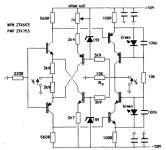Has anyone had much experience with the "Hawksford cascode" (not actually invented by Hawksford it seems but the name has stuck and we need to call it something..).
My own experiments are, I must confess, so far limited to sims and I will soon get round to some practical breadboarding, BUT results so far seem to suggest that it doesn't work as advertised! Maybe this is due to some limitation in the modelling accuracy of BJT's? Any ideas?
I have tried both single ended and push-pull configurations and experimented with variables such as collector current and emitter resistor values but results so far show at best no effect whatsoever and at worst a big reduction in gain accompanied by a large rise in distortion.
Has anyone had radically different experiences to this? I must assume that as Professor Hawksford is a well respected academic and has published a white paper on the subject (http://www.essex.ac.uk/csee/research/audio_lab/malcolmspubdocs/J10 Enhanced cascode.pdf) that it does actually work and my results are due to simulations not reporting the truth on the matter...
My own experiments are, I must confess, so far limited to sims and I will soon get round to some practical breadboarding, BUT results so far seem to suggest that it doesn't work as advertised! Maybe this is due to some limitation in the modelling accuracy of BJT's? Any ideas?
I have tried both single ended and push-pull configurations and experimented with variables such as collector current and emitter resistor values but results so far show at best no effect whatsoever and at worst a big reduction in gain accompanied by a large rise in distortion.
Has anyone had radically different experiences to this? I must assume that as Professor Hawksford is a well respected academic and has published a white paper on the subject (http://www.essex.ac.uk/csee/research/audio_lab/malcolmspubdocs/J10 Enhanced cascode.pdf) that it does actually work and my results are due to simulations not reporting the truth on the matter...
I assume it is this circuit (figure 9c from the article) that you are simulating. I will have a go myself.
It is just the output push-pull cascode part. I have tried other input stages and the cascode part on its own and tried variations around the theme....
I will try to get round to simulating his whole demo circuit (it had occurred to me!) just in case there is something subtle about the circuit as a whole that is "special" but, as I understand it, his claims refer to just the connection of the biasing components for the upper BJT to the emitter of the lower device...
I stand happily corrected 
It only works when it's driving a considerable load resistance in order to develop a reasonable swing of collector current to feed back to the emitter.
I had been doing tests into 1M and infinite load resistances to test the gain stage in isolation... Doh!
Under the right circumstances I can confirm the up to x10 improvement in distortion claimed! Also the mild gain peaking.....
It only works when it's driving a considerable load resistance in order to develop a reasonable swing of collector current to feed back to the emitter.
I had been doing tests into 1M and infinite load resistances to test the gain stage in isolation... Doh!
Under the right circumstances I can confirm the up to x10 improvement in distortion claimed! Also the mild gain peaking.....
Could you post your circuit. I'm interested in your findings.
It's just the cascode part of Hawksford's diagram, with a variable biasing network to allow for different tests at the same current, and with an op amp integrator servo to remove DC from the output.
- Status
- This old topic is closed. If you want to reopen this topic, contact a moderator using the "Report Post" button.
